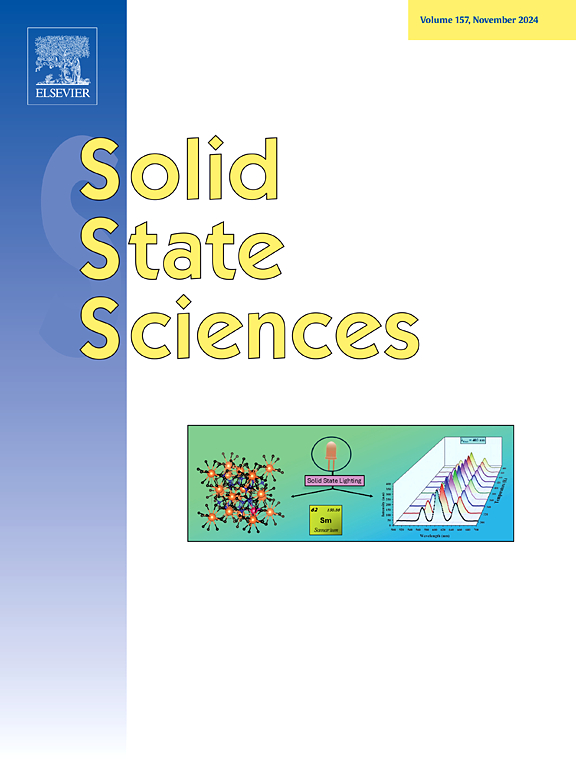Bound magnetic polarons, phonon confinement and charge transfer effects in Cr2O3/SiO2 composites
IF 3.3
3区 化学
Q2 CHEMISTRY, INORGANIC & NUCLEAR
引用次数: 0
Abstract
Cr2O3/SiO2 composites with varying Cr2O3 content (10 %, 30 %, and 50 %) were synthesized and systematically analyzed for their structural, vibrational, chemical, and magnetic properties. X-ray diffraction (XRD) confirmed the successful incorporation of Cr2O3 into the SiO2 matrix, with a gradual increase in Cr2O3 phase fraction and a minor shrinkage in lattice volume, indicative of strong interparticle interactions. Raman spectra exhibited a systematic redshift and peak broadening in the characteristic Cr2O3 mode, indicative of interfacial strain and phonon confinement, while Raman mapping revealed phase clustering at higher Cr2O3 content. X-ray photoelectron spectroscopy (XPS) identified a higher Cr6+ fraction at increased Cr2O3:SiO2 fractions, indicating enhanced Cr-O-Si interactions. Magnetic measurements at 50 K and 300 K demonstrated dominant antiferromagnetic behavior alongside weak ferromagnetic contributions, attributed to defect-induced bound magnetic polarons (BMPs). BMP density increased with Cr2O3 content, highlighting localized spin interactions at the Cr2O3/SiO2 interface. These findings elucidate the interplay of structural stability, charge transfer, and defect-mediated magnetism, offering insights for optimizing Cr2O3/SiO2 composites in spintronic, magneto-optical, and catalytic applications.

Cr2O3/SiO2复合材料中的束缚磁极化子、声子约束和电荷转移效应
合成了不同Cr2O3含量(10%、30%和50%)的Cr2O3/SiO2复合材料,并对其结构、振动、化学和磁性进行了系统分析。x射线衍射(XRD)证实了Cr2O3成功地掺入到SiO2基体中,Cr2O3相分数逐渐增加,晶格体积略有缩小,表明颗粒间相互作用强。在Cr2O3特征模式下,拉曼光谱表现出系统的红移和峰展宽,表明界面应变和声子约束,而在Cr2O3含量较高时,拉曼映射显示出相簇。x射线光电子能谱(XPS)发现,Cr2O3:SiO2组分增加时,Cr6+组分增加,表明Cr-O-Si相互作用增强。在50 K和300 K下的磁测量显示出主要的反铁磁行为以及弱铁磁贡献,归因于缺陷诱导的束缚磁极化子(BMPs)。BMP密度随Cr2O3含量的增加而增加,表明Cr2O3/SiO2界面上的自旋相互作用具有局域性。这些发现阐明了结构稳定性、电荷转移和缺陷介导的磁性之间的相互作用,为优化Cr2O3/SiO2复合材料在自旋电子、磁光和催化方面的应用提供了见解。
本文章由计算机程序翻译,如有差异,请以英文原文为准。
求助全文
约1分钟内获得全文
求助全文
来源期刊

Solid State Sciences
化学-无机化学与核化学
CiteScore
6.60
自引率
2.90%
发文量
214
审稿时长
27 days
期刊介绍:
Solid State Sciences is the journal for researchers from the broad solid state chemistry and physics community. It publishes key articles on all aspects of solid state synthesis, structure-property relationships, theory and functionalities, in relation with experiments.
Key topics for stand-alone papers and special issues:
-Novel ways of synthesis, inorganic functional materials, including porous and glassy materials, hybrid organic-inorganic compounds and nanomaterials
-Physical properties, emphasizing but not limited to the electrical, magnetical and optical features
-Materials related to information technology and energy and environmental sciences.
The journal publishes feature articles from experts in the field upon invitation.
Solid State Sciences - your gateway to energy-related materials.
 求助内容:
求助内容: 应助结果提醒方式:
应助结果提醒方式:


